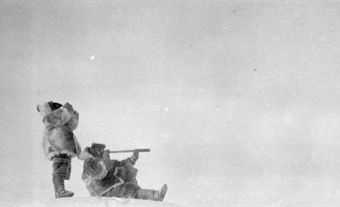Inuktitut is an Indigenous language in North America, spoken in the Canadian Arctic. The 2021 census reported 40,320 people have knowledge of Inuktitut. Inuktitut is part of a larger Inuit language family, stretching from Alaska to Greenland. Inuktitut uses a writing system called syllabics, created originally for the Cree language, which represent combinations of consonants and vowels. The language is also written in the Roman alphabet, and this is the exclusive writing system used in Labrador and parts of Western Nunavut. Inuktitut is a polysynthetic language, meaning that words tend to be longer and structurally more complex than their English or French counterparts. (See also Indigenous Languages in Canada.)

The Inuit Language
Non-Inuit typically refer to the language as Inuktitut; however, the speakers themselves have different names for the language in their own dialects. For instance, it is called Inuttitut in Nunavik (Northern Quebec), Inuttut in Nunatsiavut (Northern Labrador) and Inuktitut in much of Nunavut.
A related issue is that Inuktitut is part of a dialect continuum — a series of dialects that change gradually over a geographical area in which speakers of neighbouring dialects can understand each other, but those further apart may not be able to. This continuum stretches across the North American Arctic, including Inupiaq in Alaska, Western Canadian Inuit in the Northwest Territories, Eastern Canadian Inuit in Nunavut, Quebec and Nunatsiavut, as well Greenlandic dialects. It is for this reason that specialists refer to this entire continuum as the Inuit language, or simply Inuit, and reserve the label “Inuktitut” for the Eastern Canadian dialect group. In the 2021 census, 40,320 people reported having knowledge of Inuktitut. (See also Indigenous Languages in Canada.)
Writing Systems
Like most Indigenous languages in the Americas, Inuktitut did not have a writing system before contact with Europeans. This is not unusual because writing is a relatively recent human invention and human languages existed without writing for tens of thousands of years. (See also Oral History and Indigenous Oral Histories and Primary Sources.)
Syllabics
In Nunavik and most of Nunavut, Inuktitut is typically written in syllabics — a writing system originally created for the Cree in 1840s by James Evans, a missionary in Manitoba.(See also Cree Language.) This system was later adapted to Inuktitut, and spread by missionaries and Inuit themselves in what is now Nunavut and Nunavik.
Like the Cree syllabary, Inuktitut syllabics use a set of symbols to indicate combinations of consonants and vowels. For instance, the single symbol ᐸ represents the sounds that would be written with the two letters pa in the Roman alphabet. The system works as follows: the shape of each symbol indicates a consonant, or lack thereof, while the orientation of the symbol indicates the vowels a, i or u. Rotating or flipping a symbol changes the vowel. For instance, the syllabic ᑎ represents the sounds ti, while ᑐ represents tu and ᑕ represents ta.
One symbol is used to indicate a vowel that is not directly preceded by a consonant, such as at the beginning of a word or after another vowel. Smaller superscript versions of the symbols are used to indicate a single consonant not followed by a vowel, such as at the end of a word or before another consonant. The language distinguishes between short and long vowels. For instance, inuk means “person,” while inuuk means “two people.” To indicate that a vowel is long, a dot is placed above the corresponding syllabic. Below are two examples of the system in use.
|
ᐃᓄᒃᑎᑐᑦ
|
ᑰᒃkuu-k
|
One difference unique to the version of the system used in Nunavik (Quebec) is the use of a fourth orientation of symbols to indicate the combination of the vowels ai, which would be written with an extra vowel symbol in Nunavut. As such, the Nunavik syllabary is typically presented with an additional column. The following table summarizes both the Nunavut and Nunavik versions of the system.
Table 1: Inuktitut Syllabics
|
International Phonetic Alphabet |
Roman orthography |
Vowel |
Final |
ai (in Nunavik only) |
||
|
Consonant |
i |
u |
a |
|||
|
– |
– |
ᐃ |
ᐅ |
ᐊ |
ᐁ |
|
|
p |
p |
ᐱ |
ᐳ |
ᐸ |
ᑉ |
ᐯ |
|
t |
t |
ᑎ |
ᑐ |
ᑕ |
ᑦ |
ᑌ |
|
k |
k |
ᑭ |
ᑯ |
ᑲ |
ᒃ |
ᑫ |
|
ɣ |
g |
ᒋ |
ᒍ |
ᒐ |
ᒡ |
ᒉ |
|
n |
m |
ᒥ |
ᒧ |
ᒪ |
ᒻ |
ᒣ |
|
n |
n |
ᓂ |
ᓄ |
ᓇ |
ᓐ |
ᓀ |
|
s |
s |
ᓯ |
ᓱ |
ᓴ |
ᔅ |
ᓭ |
|
l |
l |
ᓕ |
ᓗ |
ᓚ |
ᓪ |
ᓓ |
|
j |
j |
ᔨ |
ᔪ |
ᔭ |
ᔾ |
ᔦ |
|
v |
v |
ᕕ |
ᕗ |
ᕙ |
ᕝ |
ᕓ |
|
ʁ |
r |
ᕆ |
ᕈ |
ᕋ |
ᕐ |
ᕃ |
|
q |
q |
ᕿ |
ᖁ |
ᖃ |
ᖅ |
ᙯ |
|
ŋ |
ng |
ᖏ |
ᖑ |
ᖓ |
ᖕ |
ᙰ |
|
ɬ |
& |
ᖠ |
ᖢ |
ᖤ |
ᖦ |
|
Dialect-Specific Syllabics
To accommodate sounds that are only present in some dialects, additional symbols such as ᖨ for z and ᕵ for h are used, as summarized below. The symbols ᕼ and b for h and b, respectively, are also used at times in borrowed words, such as Hᐋᑭᖅ/“hockey” but, unlike other symbols, they are not rotated and the following vowel is written with a separate symbol.
Table 2: Additional syllabics used in some dialects
|
i |
u |
a |
|
|
z |
ᖨ |
ᖪ |
ᖬ |
|
h |
ᕵ |
ᕷ |
ᕹ |
Roman Orthography
Inuktitut also has an orthography (a spelling system) based on the Roman alphabet, with some variation in the conventions used for different dialects. Again, differences between dialects are accommodated using additional letters. Versions of the Roman system are used in Western Nunavut, the Northwest Territories and in Labrador. Greenlandic dialects, also part of the Inuit dialect continuum, use the Roman alphabet as well.
The current Roman version of the writing system has already undergone standardization from an earlier version, making it more systematic and reflective of the pronunciation of the language.
Proposed Standardization
Inuit Tapiriit Kanatami (ITK), the national organization representing Inuit in Canada, has recommended the adoption of Roman orthography as the standard writing system in schools to facilitate language learning, with syllabics being introduced in later grades. In February 2016, translators and interpreters attending the Apqutauvugut Interpreter/Translator Conference in Iqaluit, Nunavut, voted in favour of such a reform. It remains to be seen whether governments and communities will accept these recommendations.
While governmental organizations have adopted standard sets of terminology for use in translations and public documents, no single variety of the language has been adopted as a standard nor is there a single standard for spelling that applies across all dialects. To a large degree, variation in spelling is due to dialects having slightly different inventories of sounds and different rules for combining them. For instance, while pronounced and written as Inuktitut in Nunavut, the same word takes the form Inuttitut in Nunavik.
Unlike English or French, for which standard spellings of each word exist, Inuktitut speakers are in large part guided by their own pronunciations of words. Another reason for variation lies in the fact that Inuktitut is a polysynthetic language — having highly complex words. The existence of such complexity means no dictionary could conceivably list all the possible words of Inuktitut, posing a challenge for the type of standardization often found in European languages.
Speaking the Language
Inuktitut, or Eastern Canadian Inuktitut, is considered a dialect group within the Inuit language. Subdialects of Inuktitut include North and South Baffin, Labrador, Nunavik, Aivilik, Kivalliq and Natsilingmiutut. The other dialect group in Canada, Western Canadian Inuktun, includes Inuinnaqtun, Siglitun and Uummarmiutun, and is spoken in Western Nunavut and the Northwest Territories. Alaskan Inupiaq to the west and Greenlandic to the east also belong to the Inuit language.
Dialects
Inuktitut subdialects vary somewhat in their sound inventories. For instance, some have a voiceless l sound (made without vibrating the vocal cords), while others have merged this sound with l, s or t. They also vary in terms of how sounds can combine. Overall, Western dialects tend to preserve more combinations, such as gl or kt, while Eastern dialects will often transform these combinations into geminates (a doubled sound pronounced longer), such as ll or tt.
Dialects also vary in vocabulary, using different words, and in the meanings assigned to morphemes, the building blocks of words. For example, the word for “now” in much of Nunavut is maanna, while in Nunavik it is taga-taga.
These differences in sound systems and vocabulary constitute the main barrier to communication between speakers of different dialects. While there are also syntactic (sentence structure) differences between dialects, they are not as pronounced.
Notable Features
Inuktitut has features that distinguish it from other languages, including its sound system, the complexity of Inuktitut words and its grammar.
Sound System
Inuktitut has a relatively small inventory of sounds, consisting of three vowels and around 14 consonants, depending on the dialect. By comparison, the inventory of sounds in Canadian English includes 24 consonants and 10 simple vowels.
Polysynthesis
Inuktitut is a polysynthetic language, meaning that words exhibit a higher degree of complexity than what is typically found in most languages. This complexity manifests itself in a variety of ways. For instance, some verbs combine with their objects to form a single word. This process is called noun incorporation, as illustrated in the following example where the verb -liuq- “make” must attach to its object, iglu “house.”
|
iglu-liuq-tunga |
|
house-make-declarative.1sg (Note: The abbreviation 1sg means “first person singular,” i.e., I, the speaker). |
|
“I’m building a house.” |
Another type of incorporating verbs needs to attach to yet another verb to form a word. Furthermore, a number of elements that serve the function of adjectives and adverbs can also appear inside larger words. Finally, while in a language like English, a number of grammatical markers exist as small words, such as articles, auxiliaries, prepositions and the like, in Inuktitut virtually all such grammatical machinery occurs within larger words. The end result is that the language has rather long words, often having structures similar to clauses in other languages, as in the following example from linguist Louis-Jacques Dorais, Illujjjuaraalumuulaursimannginamalittauq (meaning, “but also, because I never went to the really big house”).
Ergativity
Another notable feature of Inuktitut is the way it marks the participants in a sentence. In a language like English, such marking is only found in pronouns, such as they versus them, or in the difference between who and whom. In English, subjects receive the nominative case (subject form) regardless of whether or not there is an object, while the accusative case (object form) only occurs on objects.
|
They saw them. |
Transitive sentence (with an object) |
|
They left. |
Intransitive sentence (without an object) |
Such a system is called a nominative-accusative system. Inuktitut, on the other hand, has what is called an ergative-absolutive system. This means that, instead of using the same form for subjects, regardless of whether or not the clause has an object, the Inuktitut system reserves one form only for subjects of transitive clause. For instance, in the following examples, anguti “man” takes the ending up only when the sentence also has an object.
|
Anguti-up taku-jaa nanuq. |
|
man-ergative see-3sg.3sg polar.bear (Note: The abbreviation 3sg means “third person singular,” much like the s in English arrives.) |
|
“The man saw the polar bear.” |
|
Anguti ani-juq. |
|
man leave-3sg |
|
“The man left.” |
This phenomenon of treating transitive and intransitive subjects differently is called ergativity.
Did You Know?
In 2019, Inuktitut magazine celebrated its 60th anniversary. The magazine, published by Inuit Tapiriit Kanatami (ITK), was launched in 1959 to showcase Inuit people, culture, history, and language. It is now published in Inuktitut (including Inuktitut syllabics), Inuinnaqtun, French, and English and is delivered free of charge to Inuit households across Canada.
Current State of the Language
Inuktitut has official status in Nunavut, alongside English and French. In the Northwest Territories, both Inuktitut and Inuinnaqtun (a related group of dialects) are included among other “Official Aboriginal languages.” In Nunavik, Inuktitut has a recognized status in education as part of the James Bay and Northern Québec Agreement, as well as the Charter of the French Language. It is also an official language of the Government of Nunatsiavut in Labrador.
In the 2021 census, 37,050 people identified Inuktitut as their mother tongue, with the majority of speakers residing in Nunavut (19,130) and Quebec (12,770). Statistics Canada reported in 2021 40,320 speakers overall (including those with knowledge of the language, those who speak the language at home and those whose first language was Inuktitut), making Inuktitut the second most spoken Indigenous language in Canada. (The Cree language was the first.)
To address the negative effects of decades of government and institutional policies that sought to assimilate Inuit and suppress the transmission of their language, many programs and initiatives are underway to revitalize or maintain the language in Inuit communities. In Nunavut, most communities offer the first few years of school in Inuktitut or Inuinnaqtun. Nunavik’s Kativik School Board places an emphasis on Inuktitut (or Inuttitut), with this being the language of instruction from kindergarten to grade 3. In the area of higher education, Nunavut Arctic College has published several dictionaries, language learning materials, and more technical documents on terminology, translation, and grammar.
Other initiatives are also being undertaken by the Avataq Cultural Institute in Nunavik and the Torngâsok Cultural Centre in Nunatsiavut. In the private sector, the Pirurvik Centre has created a language learning website, Tusaalanga, an accompanying smartphone app, an Inuktitut phrasebook, and other language teaching materials. The Iqaluit-based publishing company Inhabit Media has published many books in Inuktitut and Inuinnaqtun for both children and adults.

 Share on Facebook
Share on Facebook Share on X
Share on X Share by Email
Share by Email Share on Google Classroom
Share on Google Classroom












